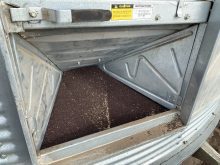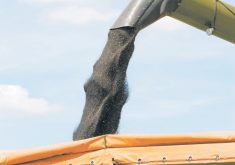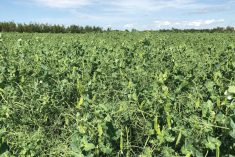Hundreds of villagers enraged over government land seizures staged a third day of protests in southern China Sept. 23, a day after ransacking government buildings and engaging in skirmishes with police that left at least 12 people injured.
The fresh demonstrations, the latest display of public fury in the economic powerhouse of Guangdong province, proceeded without violence, with protesters jubilant that government offices remained deserted after terrified officials fled.
Local government offices were gutted in Wukan one of a cluster of suburbs in Lufeng, a city of 1.7 million with broken furniture, smashed glass and papers strewn about the courtyard. A police station was deserted, its windows shattered and its sign smashed.
Read Also

Manitoba sclerotinia picture mixed for 2025
Variations in weather and crop development in this year’s Manitoba canola fields make blanket sclerotinia outlooks hard to pin down
Hundreds of villagers in the suburb signed a white banner, demanding the return of swathes of land seized in recent years.
Outside Lufeng s main government office building, farmers banged on gongs and shouted: Give us our land back. White banners held aloft said: Protect our farmland with our lives and end collusion with developers.
A statement by the municipal government of Shanwei region, which includes Lufeng, said more than a dozen policemen had been injured in earlier clashes and six police vehicles were damaged.
The protests over land seizures, generally carried out by private or state-linked companies but with the acquiescence of local governments, have persisted despite assurances from the government that it will address the problem.
We call on the central government to come and investigate these land grabs by the Shanwei government, said Zhang Jiancheng, 35. Otherwise, more villagers will rise up and cause disturbances.
We want Wen Jiabao to pay attention to our suffering, he said, referring to China s premier.
We must be united, said wheelchair-bound villager Li Shicao. If we re scared, they ll sell the rest of our land.
The disputes in a country where the government legally owns all land have spawned protests, fights with pol ice, impr isonment and suicides, and created a recurring headache for the ruling Communist Party. Earlier, protesters said they came under attack from riot police wielding truncheons.
They were hitting everyone from children to a 70-year-old woman, said Huang Shuisheng, 28, an oxygen tube attached to his nose as he lay in a hospital bed in a blood-spattered T-shirt.
Scores of others were being treated in the ward.
Villagers told Reuters the protests were triggered by the seizure and sale to property developers including Country Garden. The developer could not immediately comment.
Protests and incidents of mass unrest have risen from rapid economic transformation, according to Zhou Ruijin, a former deputy editor-in-chief of thePeople s Daily,writing in current affairs magazine,China through the Ages.
Between 1993 and 2006, the number of recorded mass incidents grew from 8,708 to about 90,000, Zhou wrote in the magazine s September edition. From 2007 to 2009, the number of incidents was consistently above 90,000, he added.
By and large, the authorities have failed to prevent … incidents of social unrest from multiplying, said Nicholas Bequelin, a China expert with Human Rights Watch. The root cause in the countryside is land grabs.


















